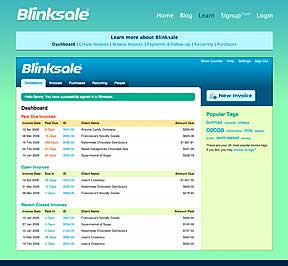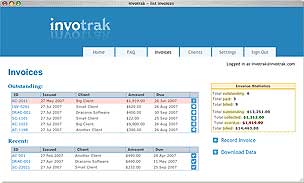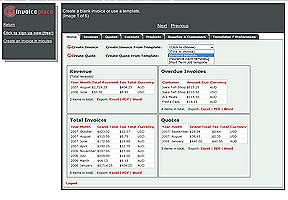nvoicing is simply the act of asking for payment. Many writers who come from the world of automatic paychecks struggle with the idea of having to go out and request payment, but it is a necessary step in a professional writer’s career. Whether a writer is working on an article for an upcoming publication or writing copy for a corporate client, she is unlikely to receive payment until her client has seen an invoice.
Beyond notifying clients of owed money, invoices serve another purpose. A writer with a good invoicing system knows at-a-glance which clients owe money and which accounts are overdue. Keeping all of that information memorized is practically guaranteeing that a payment will be overlooked or a project never paid for. Developing a process for invoicing clients is crucial to the development of a reliable writing income, as well as presenting oneself as a professional. Writers who do not make the effort to handle their invoices professionally can often find themselves losing clients due to mistakes on an invoice, arguments about payment or sheer difficulty in handling the business side of a project. In contrast, a smooth invoicing system can impress a client and making the payment process easier can predispose a client to working with a writer in the future.
Invoicing can be a relatively simple set of procedures. First, a writer who is sending an invoice to a client must include the following information:
- The name and company of the person receiving the invoice
- An itemized list of the work the invoice covers, including the cost of each item
- The total amount due
- The due date for payment and any payment terms
Most writers use a template for invoicing—they simply fill in the blanks and mail out the invoice. Generally, setting a policy regarding such issues as payment terms (interest on unpaid balances, where payment should be sent and related questions) will allow a writer to send out invoices quickly, rather than attempting to rewrite invoices for each project.
Beyond the actual invoice sent out to clients, a writer must track invoices. Tracking an invoice can be as simple and low-tech as keeping a list of when invoices were sent out and checking off each invoice as payment is made. However, there are a number of software packages that can make the process easier: less writing is necessary and software can automatically issue invoices and reminders of due dates. Even a simple Excel spreadsheet can make the process a bit smoother. Whether or not a writer uses software, tracking invoices is the only way she can make sure that clients are paying in a timely fashion.
Beyond the two key steps of sending out invoices and tracking invoices and payments, there is little else to invoicing—details simply meant to make the practice easier.
“Processing multiple invoices at once allows a writer to keep on writing...”
Invoicing can seem overwhelming, and most writers would rather write than spend time sorting out past due payments. Streamlining the process as much as possible can prevent a writer from dedicating too much time to the invoicing process. Even the smallest improvement on a writer’s invoicing procedure can provide a few more minutes to get back to writing.
Stick to one invoicing policy. Many writers try to accommodate clients by adjusting policies for each client. However, it rapidly becomes difficult to remember what terms were set for one client’s invoice and those set for another’s. If a writer must break her own policy, she needs to track those deviations as closely as the payments she receives.
Process invoices together. Rather than create an invoice as each project ends, it is easier to process a whole set of invoices at once. For instance, a writer might prepare the invoices for a full week of work on Monday morning, and only send them out as she finishes each project. Processing multiple invoices at once allows a writer to keep on writing, rather than attempting to pause and shift to thinking about business, and then trying to start writing again. The same applies to sending out reminders and dealing with past due invoices.
Use software that automates invoicing.
Writers can use software programs to automate their invoicing procedures, reducing the time necessary to send out invoices. For instance, software packages can issue automatic email reminders to clients who have unpaid balances, saving the effort necessary to check through a long list of invoices for such offenders. There a wide variety of software options, including a number of web applications that can provide more flexibility than software installed on one’s desktop.
Provide payment options in the invoice.
Answering clients’ questions about payment, such as where to send the check, can save an endless back-and-forth of emails and phone calls. Providing an address or a Paypal (https://www.paypal.com) account means that a client has no excuse to delay sending out payment. Other details a writer should consider including is an easy method of contact for questions and a clear explanation of any charges that might confuse a client.
Prepare for collection.
Every writer who has been in the business for a while has had a client who just didn’t pay up. For smaller invoices, it may not be worth attempting to collect, but for larger projects with a significant sum of money at-stake, it can be well worth a writer’s effort to collect. Every writer should have a collections policy in place: a certain number of phone calls asking for a check and a method to keep track of those calls is a good start. Considering small claims court for an escalated situation may not be out of the question—but a writer making a legal case better be able to bring in copies of invoices, as well as be able to point out specific dates she mailed them and other contact she had with a client about the issue. Using a reliable invoice tracking system can guarantee that a writer has necessary proof in extreme situations.
There are benefits to using web applications—software that doesn’t need to be downloaded and installed on a computer—to manage invoices. Many web applications offer a host of options that simply aren’t available elsewhere, including automatically emailing invoice reminders and linking invoices to Paypal (https://www.paypal.com) and other payment options. Many online applications even offer free accounts, which can be easier on a writer’s budget than picking up expensive software that must be regularly updated. However, most only offer limited free accounts, with premium accounts available. The prices for premium accounts are usually relatively low compared to the cost of other invoicing options.

Blinksale (https://www.blinksale.com) is one of the best known invoicing options available online. It allows a user to create an invoice for a client and have that invoice automatically delivered via email. Blinksale’s popularity is due to the wide variety of options it offers: users can choose their preferred currency, add sales tax and shipping fees, request payment through Paypal and even create reoccurring invoices. Blinksale also works with a number of other web applications focused on project management, such as Basecamp (https://www.basecamphq.com). However, users who choose the free option are limited to sending only three invoices a month—not ideal for most writers.
In addition to their free accounts, however, Blinksale has several premium accounts, ranging in price from $12 to $49 per month, and based on a rising number of invoices sent in a given month.

Invotrak (https://www.invotrak.com), while less popular than Blinksale, offers full use of its services at no cost. It is a slightly more limited piece of software—no fancy currency options—but it does offer users the ability to track their working hours. This useful feature not only helps provide writers with precise billing information for freelance clients but can help a writer determine just how much time she is spending on a particular project (and decide if it’s really worth the pay). Invotrak also sends email reminders to its users about approaching due dates and past due invoices.

InvoicePlace (https://www.invoiceplace.com) is an ideal invoicing option for writers planning to send out quotes for future projects. In addition to its flexible invoicing options, InvoicePlace allows users to prepare quotes and use them to create invoices. It even allows for the break down of taxable and non-taxable items on an invoice. The free account for InvoicePlace, however, is fairly limited: a user can only create invoices for three customers without paying for a premium account. Premium accounts begin at $15.
There are a few weaknesses to online invoicing, however, that a writer should take into account before selecting an invoicing method. The benefit of being able to access one’s record from any computer with an internet connection does mean that it is easier for other people to access those records as well. While most web applications take care to secure their websites, it is impossible to fully prevent such occurrences. Furthermore, web applications themselves present an issue of data portability—some web applications provide no easy way for users to move their information to another software program in the future.
As a writer, it can be easy to focus on writing to the exclusion of earning money. Even writers need to eat, however, and invoicing is the easiest way to make sure writers receive the payment they're owed for their work. Rather than relying on memory, a writer can use a simple invoice system to handle the paperwork—and allow her to get back to writing quickly.
***

BIO:
Thursday Bram is a freelance journalist with over five years experience. Her work has focused primarily on small business topics as she tries to make life easier for entrepreneurs.
More information about Thursday is available at www.thursdaybram.com.